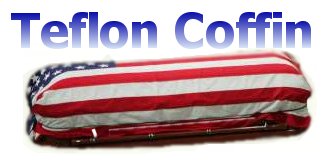Art Pottery, Politics and Food
Friday, June 11, 2004
Thursday, June 10, 2004
Cincinnati’s annual spring Art Pottery auctions took place this past weekend among the city’s rivalist Capulet and Montague fine art houses.
Treadway event at the Union Terminal's Museum Center
Due to circumstances beyond my control, I was only able to attend Saturday’s usually frantic and poorly catalogued Treadway event at the Union Terminal where my attention was drawn to a large offering of very rare Kenton Hills Porcelains from a private Ohio collection.
A selection of Kenton Hills with a Rookwood portrait mug
Why are these pieces rare?
Kenton Hills was only in operation for a brief period between May of 1940 and early 1943 when firing stopped forever.
Their short production life means that modern collectors are limited to surviving examples from an output totaling a maximum of 10,000 production and artist-signed ceramic pieces.
Rookwood collectors, on the other hand and without any slight intended, benefit from that pottery’s long production history and a collectible pool of more than a million available pieces.
Still, reasonably priced Kenton Hills examples, with glaze lines and some designs rivaling Rookwood, have the potential to offer the average collector significant value.
The great bulk of Kenton Hills ceramic ware arriving on the modern market are high or glossy glaze examples.
This past weekend’s frenetic Treadway event was no exception and included several even more rare and beautiful matte glaze examples that, to this observer, sold for a song.
In my rarely unvoiced opinion, many of larger artist-signed Kenton Hills examples, intended as lamp bases, have a hurried quality that limits their artistic appeal and will, no doubt, hinder their collectable value despite the $1000+ prices hammered-down last Saturday.
Sometimes, dear reader, size isn’t everything.
I feel that, over time, the smaller matte glazed Kenton Hills pieces will realize greater increases in collectible value due to their unique design and artistic purity.
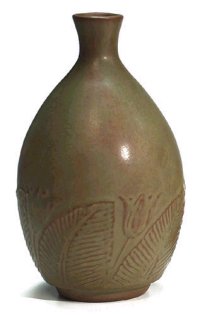
For example this superb and most unusual rust-colored and 6” egg-shaped porcelain body with relief stylized floral design and matte olive glaze by William Ernst Hentschel and bearing the early Harold Bopp tulip mark is, I think, a beautiful clay pot by anyone’s standard and worth far more than Saturday’s hammer price of $500.
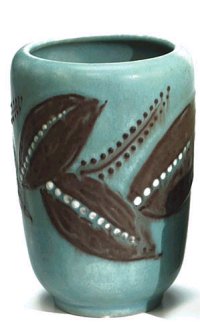
This lovely and almost organic 6” matte glazed footed vessel, also by Hentschel and so evocative of some of his Rookwood designs, possessed unique qualities unnoticed by the catalogue and consequently the potential bidding audience.
The very tactile and raised peapod design is not just ceramic.
Close examination reveals that the white peas, in the design, are not clay slip but, rather, quartz beads pushed into the unfired porcelain or kaolin body.
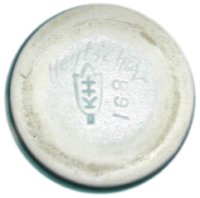
Additionally and unlike most of Hentschel’s pottery work, this vase is signed with the artist’s incised full last name.
The tulip mark on this later pot has elongated into what is called the lotus shape containing upper case letters K and H.
Had the quartz peas and the signature been mentioned in the catalogue, I'm confidant this beautiful vase would have hammered at a value greater than Saturday’s $350.
Another Hentschel piece short-changed by the catalogue is this 6 ¾” pink matte flower form vase.
In addition to a tulip mark and Hentschel’s incised initials, the pot bears an incised inscription from the artist to his sister Jen and, according the Kenton Hills author Marilyn Nicholson, was acquired out of the sister’s estate.
A color photo of this pot is in the Nicholson book.
This information was not catalogued and consequently the pot hammered for a mere $200.
I highly recommend the Nicholson's latest Rookwood Pottery Identification and Value Guide: Identification & Value Guide: Bookends, Paperweights, Animal Figurals.
Their research on the Rookwood Pottery's finishers is virgin territory and the Nicholson's offer timeless scholarship.
Flash!
A phone call to the fine people at the Cincinnati Art Galleries revealed another shattered sales record by that stellar establishment this past Sunday during their 15th annual Rookwood event.
Lot 1133, displayed and described in a May 18th post and with an estimated auction value between $125,000 and $150,000, hammered to a private collector at an astonishing and world record breaking price of $350,750!
Political Must Read!
John Gorenfeld shows how our cash hungry Washington insiders are being ensnared by humanity's self-alleged Savior, Messiah, Returning Lord and True Parent the Rev. Sung Mung Moon:
Should Americans be concerned that on March 23rd a bipartisan group of Congressmen attended a coronation at which a billionaire, pro-theocracy newspaper owner was declared to be the Messiah – with royal robes, a crown, the works? Or that this imperial ceremony took place not in a makeshift basement church or a backwoods campsite, but in a Senate office building?
Really, really scary.
Reference: Kenton Hills Pottery An Artistic Success but A Wartime Casualty by Nick and Marilyn Nicholson, Northern Kentucky Heritage Magazine Vol. IV No. 2
Photos: Sean, David Kalonick
Wednesday, June 09, 2004

Looks like a certain cranky G-8'er is having extra desserts and staying up past his bedtime.
Photo: Reuters
Sunday, June 06, 2004
My first encounter with Ronald Reagan was May 23, 1983.
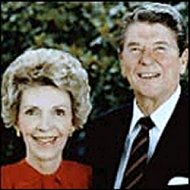
I know this for an absolute fact thanks to a period when dim-witted but cash-flush executives doled out engraved silver and pewter cups and plates to mark specific client events.
This plate, in particular, damns with the faint praise of my alleged “best effort”.
I’ve always kept it on a prominent fixture in the bathroom.
As my story begins I’m recovering in a private hospital in Washington’s Virginia suburbs following months of exploratory testing and a final delicate experimental surgery on my back.
An associate producer and a producer on my programming staff and several technicians were of great assistance during this period and I‘m grateful for their kindness to this day.
The executives and the news department were another story.
My direct superior and Executive Producer, busy juggling a two hour workday and a recently inflamed sexual relationship with her superior the station’s married Baptist minister Program Director, managed her first telephone call in the last week of my three month hospital stay.
A project, babe, maybe a little rushed but perfectly suited to those special talents, she gushed.
The project was to be the prototype for the Best of Class valedictorian spots still being made today with a rearranged, and no doubt digitally enhanced, tune first funded, then, by General Motors.
I was to make a series of 30-second commercials involving groups of ethnically diverse top Washington DC area high school graduates.
The spots, a mammoth effort involving multiple crews, were to be shot in one day at various locations spread about the Navel Observatory and Vice Presidential grounds on Massachusetts Avenue, NW.
The White House, with the 1984 election year looming, found this cornucopia of youthful ethnically balanced pre-selected student excellence hard to resist and offered the idea of a scene with the President and a small group of students for use in the commercial series.
This ultimately successful Dever-finessed pre-Fowler effort to massage the Equal Time provisions was met with predictable executive glee as student stars were refigured into Gipper co stars.
Complicated planning suddenly exploded as a presidential event was created and jammed into the projected day’s concluding luncheon and each commercial’s triumphant ending.
As this event was post Hinckley, security was super tight for that time.
Everyone, staff and students, went through background checks and ultimately a metal detector.
We were told that the President’s feet could not touch the ground at the outdoor luncheon and so raised platforms had to be constructed from where the President would alight from his limousine to the podium where he would speak.
It was also mandatory that blue curtains be erected to line the presidential path from car to podium guaranteeing a flattering backdrop for the presidential head.
The selection of the students who would shake hands with the President became a top-secret eyes-only activity.
The Observatory’s most senior political residents were, excepting an edict to keep the kiddies off the clay court, surprisingly invisible during this event.
The day and the commercials, while nearly returning my humble person to a hospital bed, ended with the success my talented programming staff and I usually guaranteed regardless of obstacle.
The day’s weather could not have been more beautiful nor the students more charming.
The President arrived with a crash of sirens and an explosion of media and chase cars.
A logistical error had positioned the national press behind my group of Presidential hand shakers.
Irate diva photographers, not knowing the plan, kept yelling for the students and myself to get out of the way.
My poor still bandaged back throbbed.
I was exhausted and unsure what to do.
The President caught my eye, looked at squawking press, returned his gaze, nodded and winked.
I smiled, nodded and told the anxious kids to stay put until it was time to shake Reagan’s hand.
Just as quickly the day ended with press and President vanishing like a coach at midnight as I headed to edit booths with reams of videotape.
Photo: Reuters

